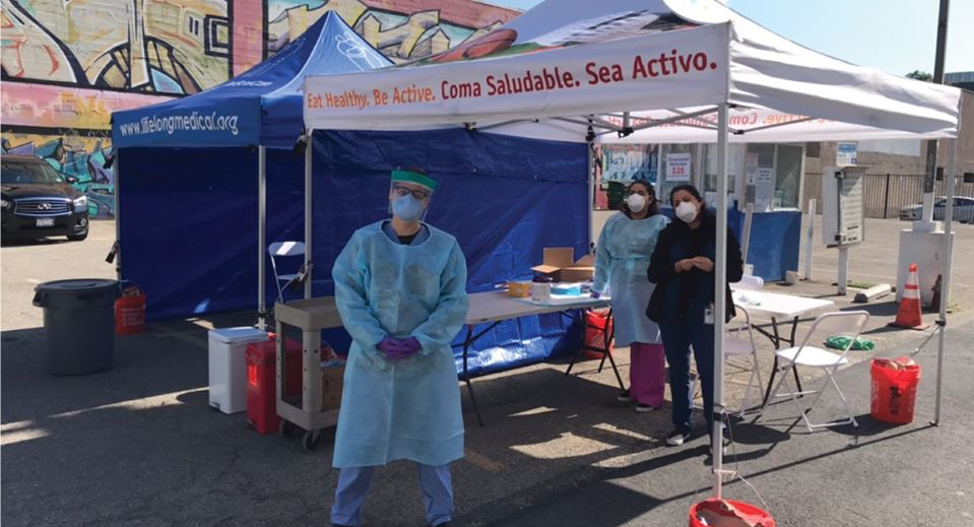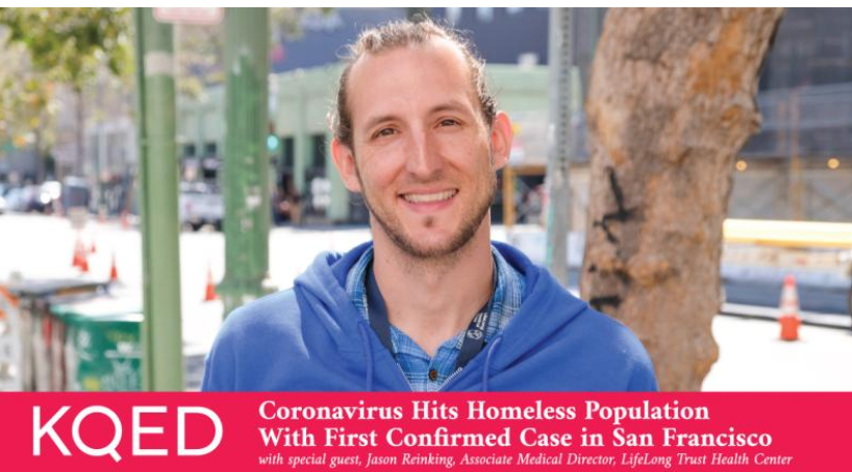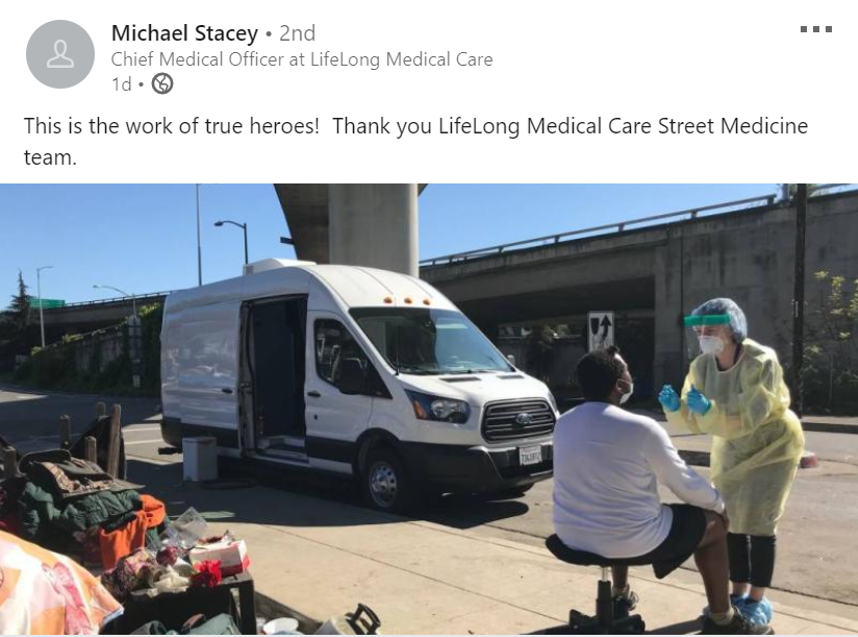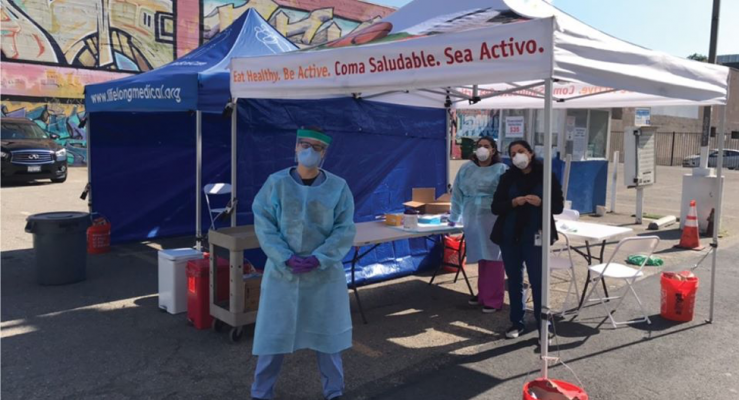
In the fall of 2019, when Dr. Michael Stacey was hired as chief medical officer at LifeLong Medical Care in California, he had no idea of the public health emergency he would soon be grappling with.
But in the spring of 2020, as COVID-19 raced through the world like a bushfire, his background proved auspicious. After medical school, Stacey had served six years as a physician in the US Air Force, including overseeing emergency services for some 16,000 people at different posts in Europe. “As much as anyone can be prepared for something like this, I do think being in the Air Force helped,” Stacey says. “You do a lot of exercises in the military preparing for worst-case scenarios.”
Equally valuable, as it turned out, was his training in public health. Stacey earned a Master of Public Health degree at UC Berkeley while working as a deputy health officer, chief medical officer and then director of medical services in Solano County Medical Services, where he helped stamp out tuberculosis outbreaks and was involved in combating the H1N1 “swine flu” pandemic.
“In public health, one of the scenarios we talk about all the time is pandemics,” Stacey says. “I’ve done a lot of tabletop exercises for pandemic preparedness – that’s all been very valuable, but of course, it is nothing like being in an actual pandemic.”
Nonetheless, Stacey’s training in pandemic preparedness may help explain why LifeLong began planning for an influx of COVID-19 patients — and a move to telehealth — early on. “We haven’t been doing a lot of swabs, but we are bracing for the oncoming wave of sick patients,” Stacey says.
The Innovation
The safety net health center, which offers medical, dental and social services to 66,000 underserved patients in Alameda, Marin, and Contra Costa Counties, started overhauling its workflows and protocols in early March. By mid-March — a day after California’s governor ordered the state’s 40 million residents to stay home and shelter in place — the clinic was scheduling telehealth visits for most of its patients and using outdoor tents to examine people with possible symptoms of COVID-19.
“We didn’t know at first if the telehealth treatments were going to be paid for,” Stacey recalls. “We had heard maybe we would get a partial payment, but even that was not certain. It was a huge relief to know we were getting paid for doing the right thing.” It was an added relief to find that the Centers for Medicare and Medicaid Services (CMS) pledged to pay clinics the same rate for telehealth as an in-person visit until the public emergency was over.

Under LifeLong’s new safety measures, in-person visits include prenatal and newborn check-ups as well as people with a chronic disease. However, newborn and prenatal patients are separated from all other patients — including those who might have COVID-19 or a chronic disease — by scheduling them for in-person visits on days or times of day when they are the only patients seen at the clinic.
As in many other health centers, patients with respiratory symptoms are examined in outdoor tents. Outside its Trust Health Center in downtown Oakland, which ministers to the homeless, LifeLong has set up a tent in the parking lot where providers can evaluate people with respiratory symptoms and test for COVID-19 when indicated.
Most of the tents were repurposed from equipment the health center already had in storage; one was donated. “We sometimes use tents for outreach events like street fairs,” said Stacey. “We schedule patients for appointments in the tent and see one person at a time. The tents don’t need any special disinfection because they are well-ventilated and don’t come into contact with the patient.” The location of the tents varies by clinic. “At some clinics, you’re able to drive up to get a COVID-19 test only and get that done in the car.” The tents that are used for COVID-19 testing are separate from the tents used to evaluate patients with respiratory symptoms, he said, adding that the tents for respiratory evaluation were not drive-through.
At the Trust clinic itself, LifeLong has also tried to keep the schedules open and let people keep appointments or walk in.
“Telehealth doesn’t work that well for the homeless,” Stacey explains, adding that LifeLong street medicine teams using protective equipment are still making visits to homeless encampments and SROs, as described in a recent New York Times piece. “There are all kind of logistical problems that make it hard for them to reschedule an appointment — for example, they can’t just leave their belongings. We do screen everyone at the door, however if people have [respiratory] symptoms, they’ll be evaluated and treated outside.”
Stacey finds it remarkable how well providers at LifeLong and elsewhere have risen to the challenge of the pandemic.
“I’ve just been humbled and really amazed at how flexible and adaptable everyone has been,” he says. “It’s a crisis moment, and I’m continually inspired by our providers and frontline staff — at how much they care and their passionate devotion to their patients.” He recently tweeted his appreciation to his street medicine team:

Noting that LifeLong has just rolled out a new texting system called Well — a system used by several other health networks who’ve participated in CCI programs — Stacey also sees a silver lining to the telehealth visits. “One big challenge for providers is no-shows,” he explains. “Now, when we’re calling patients, they’re a lot less likely to no-show and they appreciate hearing from us. Of course, we have a particularly captive audience right now. We’re looking at this as an opportunity to do a lot of preventative work — we’re making plans to do additional outreach during this time. There are opportunities to get really engaged with our patients, who are looking for something to do.”
Testing Woes and Supply Shortages
Like many other health centers across the country, however, LifeLong has found its innovation and effectiveness threatened by shortages of medical supplies, protective equipment and COVID-19 test kits.
“We have not run out of N-95 masks yet, but our supply is limited,” Stacey says. “We do know that we’re in this for the long haul, so we may not have enough to get us through the pandemic. We’re working on that constantly. Surgical masks are also hard to find. We use a lot of those. We implemented a policy that all our staff have to wear surgical masks all the time, as well as the patients. We’re also low on face shields for eye protection, very low.”
Test kits shortages continue to plague the health center as well.
“The testing availability has been horrible through this pandemic,” Stacey says. “It is hard to listen to the White House saying how many are being rolled out, when on the ground we can’t even get the swabs to do the testing. There’s such a disconnect — it’s infuriating, really. We are constantly trying to scrounge up the rights kind of swabs to do testing — we can get maybe 100 at a time, and labs need the re-agents to run their tests. The labs have been so overwhelmed that we’re having a seven-day turnaround for test results. The [commercial] labs are not able to meet the demand for all the test that are needed.”
A Partnership with the City and UC Berkeley
However, one bright spot is a new collaboration with the City of Berkeley and the University of California at Berkeley, whose labs will begin processing LifeLong’s tests for COVID-19 this week.
Stacey explained they initially started working on plans with the City of Berkeley, where LifeLong is based, so the health center could do COVID-19 testing for the city’s first responders — the police and fire department. (LifeLong will also work with the Berkeley public health department to do testing of individuals identified by the health officer for community control of the virus.) During the planning process, the health center learned that UC Berkeley’s Innovative Genomics Institute (IGI), famous for developing a gene editing molecular tool called CRISPR, had dedicated lab space and resources to coronavirus testing. After discussions with the university, LifeLong entered into a collaboration with UC Berkeley’s IGI lab to do COVID-19 testing for the city of Berkeley as well as its homeless encampments and vulnerable populations tested by the health center at its testing sites in East Oakland, the Trust Clinic in downtown Oakland, the William Jenkins Health Center in Richmond and street medicine teams in Oakland and in Berkeley. At the UC Berkeley site, LifeLong will also do testing for the city of Berkeley’s firefighters, police officers, nurses and other essential city employees.
“I think it’s extraordinary that this lab has been converted over to COVID-19 testing, which is a striking example of a public university answering the needs of the community during this crisis,” Stacey said. “To be able to do COVID-19 testing for the university, the city, and its most vulnerable population — the homeless, who are under-tested, have multiple medical conditions that put them at risk, and are unable to comply with social distancing because of their living situation: This expands our capacity and gives us the capability we didn’t have before to expand testing and help prevent the spread of COVID-19 among the homeless and other vulnerable populations.”
As of April 8, Berkeley had 34 lab-confirmed cases of COVID-19 but has not yet seen a death from the virus. Prior to working with UC Berkeley, Lifelong found 4 positive cases out of the 170 individuals it has screened from the three counties it serves. It is still waiting on results from 70 screens. In Alameda County as a whole, cases of the novel coronavirus have reached 674 — part of the 17,500 reported by the state of California, the San Francisco Bay Area has reported 4,000 confirmed cases and 100 deaths. However, the disease spread is slower than it is in New York, which some experts attribute to California Governor Gavin Newsom’s shelter-in-place restrictions announced in mid-March, and a new model projects the number of statewide deaths to be lower than expected.
“I feel for our public officials who have such tough decisions to make,” says Stacey. “The implications are huge. Everyone needs to heed the authorities and stay home…We’ve got to flatten the curve.”
![]()
VOICES FROM THE FIELD: INNOVATING DURING THE COVID-19 CRISIS
This series is based on the extraordinary work that frontline health care staff are doing in the current public health emergency. Do you want to share a story about COVID-19 and the health care safety net? Please get in touch!
Find this useful or interesting? We’re constantly sharing stuff like this. Sign up to receive our newsletter to stay in the loop.

